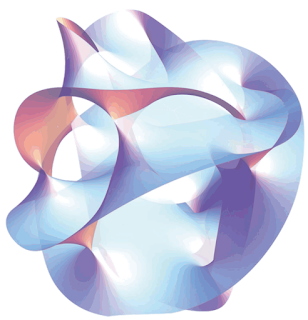String Theory Geometry - What Is Distance In String Theory?
String Theory Geometry Part 3
One being in the garden hose universe tried to measure the radius of the universe and gets 10. The other gets 0.1. They both then create tables of the possible string energies and find that despite the radii are very different, the tallies are identical but arranged differently. One being (Sam) knows about string theory and says
"usually two different radii of universes gives different string energies but if the radii are inversely proportional, energies and charges are identical. What one person calls vibration mode energy is what the other calls winding mode energy and vice versa. The universe does not care about what we call it because physics is governed by the fundamental ingredients (mass and charges). Because they are the same in both universes, there is no way to distinguish between inversely related radii."
This is all good to claim but doesn't really make sense intuitively. If the 3 extended dimensions turn out to be circular, then the radius of our universe will be at least 15 billion light years. According to string theory; this is exactly the same as claiming we live in a universe with a radius less than 1 x 100-100m. How can a 6ft tall human fit in a universe billions of billions of billions etc... times smaller than an atom? How can string theory claim that distances below the Planck length do not exist, yet have a universe trillions of trillions of trillions times smaller than the Planck length?
What Is Distance?
The way we measure distance is 1. Move a probe at speed v across the distance2. Measure the time taken to cover the distance
3. Multiply the speed times the time
We have found that strings have two possible configurations however and so there are two possible probes. This means there are two definitions of distance.
1 Probe not wrapped around the circular dimension can probe the full circumference of the circle. This length they can probe is proportional to the radius of the circle.
Length it can probe ∝ R
By the uncertainty principle we also know that
Energy of the probe ∝ 1/R
There is an inverse relationship between the energy of a probe and the distances it can probe.
The same argument can be made for wound strings
They have an energy ∝ R
And so the length it can probe ∝ 1/R
For us R and 1/R are very different and so one method of proving becomes very hard because one probe would need to have a huge mass. Unwound strings have energy ∝ 1/R
but wound strings have energy ∝ R and so are massive. When we measure the objects in our universe, we use low mass string modes (photons) and so we see a universe with radius 43.6 billion light years.
If we managed to find a heavy enough probe, we would actually measure a universe with length 1/R and this universe would be contracting.
The inverse relationship means the big crunch is avoided. Instead when R drops below 1, the other method of measuring distance becomes easier. We would therefore measure the universe as expanding again.
Why Are We Suddenly Mentioning Sub Planck Length Distances?
String theory allegedly bans sub Planck length distances, but now we are claiming we can get distances far below the Planck length? The reason why is that our normal notion of distance is using light string modes and it is in this meaning of distance that sub Planck length distances are banned. If we used heavy string modes, then we will no longer use our conventional notion of distance. Despite this difference in distance, the actual physics we encounter would be inertial to that in which the radius is 1/R
If our 3 extended dimensions are not actually circular, then theorists are not sure whether these conclusions will be correct as strings may not be able to wrap around extended dimensions. I think it would be pretty cool if our universe is circular however and this relationship does hold.
Thanks for reading. If you enjoyed this post or any of my others, follow and subscribe to my blog. Feel free to discuss anything related to this post or ask questions in the comments below.
Check Out My Previous Posts On String Theory! (Link To All String Theory Posts)
Did you see my previous post? Click the link below to check it out

Comments
Post a Comment